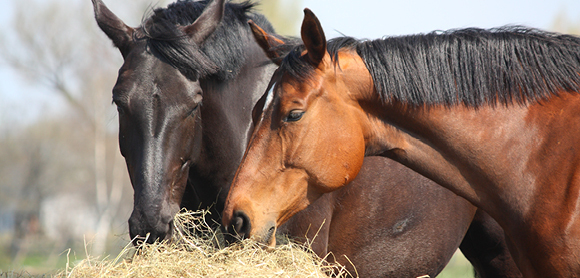
A horse owner’s guide to summer
From horse flies to sunburn, summer can be challenging for horses and their owners. Equine vet Gil Riley shares his tips and advice for this time of year.

Long, summer days and bright blue skies are usually celebrated among horse owners – but you might also be worried about how you will care for your horse in warm weather.
‘Summer is the perfect opportunity to spend more time with your horse,’ says Petplan Equine vet Gil Riley. ‘And by being aware of summer-related conditions, you can catch them early and treat them appropriately.’
Common summer problems
Here’s a rundown of some of the most common issues horses and their owners face over the summer, plus advice on how to manage them.
Pasture allergy
Also known as pasture-associated asthma, Pasture allergy occurs when horses develop an allergic reaction to something in the environment, such as dust or mould spores. ‘Horses with pasture allergy will often cough, sound like they’re wheezing, have a creamy-white nasal discharge, and be intolerant to exercise,’ says Gil. ‘You may also see “heave” lines where the horse over-develops a specific muscle in their abdominal wall to compensate for the laboured breathing.’
How to help: Vet treatment is essential, and will normally involve bronchodilators or steroids to help open the airways and ease breathing. ‘Management also involves reducing dust in your horse’s environment as much as possible via dust-extracted bedding, soaking hay, keeping stable areas clean, and ensuring good ventilation in the stable,’ advises Gil.
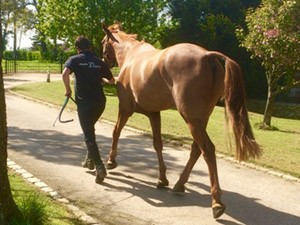
Fly issues
Sunshine and warm weather brings out the flies, which can irritate your horse’s eyes. In mild cases, this might just involve your horse’s eyes watering more than normal, but extreme cases can cause infections. Flies such as mosquitoes and horseflies irritate your horse by biting them, while bot flies lay eggs on their coats
Horses with sweet itch are normally more affected during the warmer months when midges appear. ‘Horses with sweet itch suffer an allergic reaction to the midge saliva, which causes intense itching – they can scratch to the point of making themselves bald and break the skin,’ says Gil. ‘Preventing them from being bitten is the first port of call and this is where sweet itch rugs, repellents and masks can help. It’s also wise to turn them out in the middle of the day, when midges are less abundant, keeping them indoors in the early morning and late evening.’
How to help: Follow these tips to prevent flies from bothering your horse:
- Use fly rugs and masks
- Use fly-repellent sprays, creams and gels
- Remove droppings from the paddock and stable – these are breeding grounds for flies
- Bring your horse in during the day and turn out at night
- Avoid turning out at dawn and dusk when biting flies are most active
- Position the muck heap as far away as possible from your horse’s stable or field
- Clear up any loose wet hay, straw and other organic material from around the yard – again, this material is great for fly eggs
Sunburn
Just like us, horses can get sunburned. Horses with pink skin and white markings are more at risk.
How to help: Using fly masks and rugs with UV filters can help, as can applying horse-safe sunblock to any lighter areas such as the muzzle.
Photosensitisation
Photosensitisation can be primary or secondary. Primary occurs when horses eat certain plants, including St John’s wort and clover, which makes them more sensitive to sunlight. Secondary occurs due to liver damage and this also causes an extreme reaction to sunlight. Both types of photosensitisation look similar to sunburn, but can also cause the skin to peel away.
How to help: For photosensitisation, soothing ointments and shampoos can help, but if there are signs of infection, your vet may prescribe antibiotics. Secondary photosensitisation needs to be diagnosed via blood tests, followed by a treatment plan. If you have horse insurance, the costs of diagnosis and treatment may be covered.
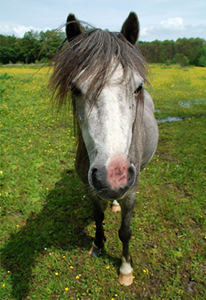
Heat stress
Most horses in the UK cope well over the summer. But as summers get hotter, there’s an increased risk of heat stress. If left untreated, this can cause organ failure, which is sometimes fatal. Signs to watch out for include:
- Panting
- Lethargy
- Flared nostrils
- Muscle tremors
- Excess sweating
- Increased respiration rate
How to help: Avoid riding during the hottest part of the day and stick to early mornings or late evenings. If possible, change your planned exercise to shorter, easier options. When it’s very hot, consider not riding at all.
If you’re concerned your horse does have heat stress, call the vet. Move your horse into the shade, offer them a drink, and continuously pour cool water over their bodies. Allow this to dry naturally; don’t scrape it off. While you’re waiting for the vet, gently walk your horse around.
Dehydration
Working your horse on a hot, humid day can make them sweat more than normal. This may mean they become dehydrated or suffer from other conditions such as muscle cramps or tying up, due to electrolytes being lost as they sweat.
Check for dehydration by monitoring the elasticity of your horse’s skin. If the skin stays elevated after being pinched and does not pop back to normal immediately, your horse may be dehydrated.
Other signs of dehydration include:
- Dark urine
- Increased heart rate
- Dull, listless behaviour
- Shallow, rapid breathing
- Passing urine less frequently than normal
How to help: If you’re concerned your horse is dehydrated, speak to your vet for advice. ‘To avoid dehydration, always make sure your horse has plenty of fresh drinking water,’ says Gil. ‘If they’re a fussy drinker, consider adding natural flavourings to their water to encourage them to drink. You can also wet your horse’s hay and give them soaked feeds and mashes to increase their fluid intake. Supplement the lost salt with electrolytes and ensure they have access to salt licks.’
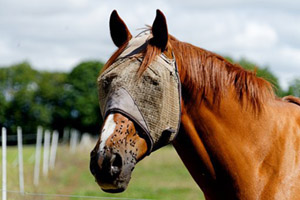
Concussion
Over the summer, hard ground can cause concussion to leg bones and bruising to the feet. If the trauma to the foot is serious, a blood blister, possibly leading to an abscess, may develop. Signs of concussion include:
- Heat in the hoof
- Sudden onset lameness
- Swelling in the fetlock joint
- Resistance to working forwards
How to help: Avoid intense, fast work or jumping on very hard ground. Make sure to warm up and cool down adequately, and cold hose or ice your horse’s legs after a strenuous workout. ‘Horses with concussion need rest and possibly pain relief depending on how bad it is,’ says Gil. ‘It may also be necessary to speak to your farrier about placing a pad under the shoe to provide some support and protection to the sole. Remedial farriery may be necessary to improve the hoof balance and prevent further problems.’
If your horse has a concussion, speak to your vet and/or farrier for advice.
Wet weather worries
Summer in the UK is often characterised by sunshine and showers – but rainy weather can increase the risk of the health concerns outlined below.
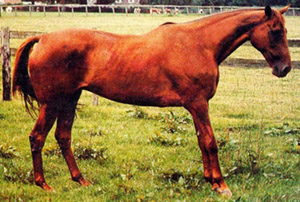
Laminitis
After a warm, dry spell, rain can encourage grass growth, which can put horses with metabolic diseases at higher risk of laminitis. The reason is that in sunny weather, grass produces sugars via photosynthesis. When the sun sets, grass then uses these sugars to grow overnight. By early morning, the sugar levels in the grass have usually dropped, making it safer for horses to eat.
‘The exception is when the grass is stressed such as from drought, excessive heat or an overnight freeze, where grasses will not have converted the sugar they synthesise during the day into fibre for growth overnight, and remain high in sugar in the morning,’ explains Gil.
How to help: ‘If your horse is at risk, remove them from the grass or limit their intake using track systems and grazing muzzles, or turning them out early in the morning,’ advises Gil. Ask your vet for advice if you’re unsure of the best time to turn your horse out during certain weather conditions.
Rain scald
This is one of the most common summer skin conditions in horses and is often seen in warm, wet weather. Rain scald is a bacterial infection of the skin, and creates matted scabs across the back and rump. Occasionally, these scabs also affect the lower legs.
This happens when a horse’s skin is exposed to long periods of wet and warm conditions. Rain scald is more common in horses with low immunity, for example young, old or poorly horses. ‘Rain scald presents with bald, scabby patches that can exude a golden serum that dries into a scab,’ explains Gil.
How to help: ‘Treatment involves gently washing the area with an antibacterial agent such as chlorhexidine or iodine to kill the bacteria, and then thoroughly drying the skin. It’s important to allow the skin in the area to recover fully to prevent reinfection, so rugs should be used during wet periods. It’s also important not to share the rugs, tack or brushes of an infected horse.’
Hoof infections
In warm, wet weather, horse’s hooves can be more prone to infections such as white line disease, thrush and abscesses. ‘When the hoof is wet for long periods, it can soften the tissues and this allows foreign material such as sand, gravel, silt or bacteria to enter the hoof and cause infection,’ says Gil. ‘With a foot abscess, the horse often becomes suddenly lame, and the hoof will be hot to touch.’
How to help: Owners can reduce the likelihood of hoof infections by:
- Keeping hooves clean, including soles, of mud and manure.
- Ensuring horses have somewhere dry to stand to allow their hooves to dry out.
- Following an appropriate hoof-care regime with your farrier to ensure hooves are well trimmed, strong and in balance.
- If your horse does develop an abscess, you’ll need to speak with your vet. They may trim your horse’s hoof to allow any pus to drain, and then you’ll need to apply a poultice.
Do horses' hooves grow faster in the summer?
Sometimes yes, which means they may need trimming or shoeing more often.
Can you clip a horse in summer?
While most horses aren’t clipped in summer, sometimes it’s the right choice. This includes:
- Cooling: If your horse has a lot of hair, clipping them in summer can help them feel more comfortable.
- Managing medical conditions: Horses with Cushing’s disease tend to grow long, thick coats, so are often clipped all year round.
- External parasites: Treating lice infestations may be easier if your horse is clipped, but be sure to disinfect any brushes, clippers and clothing after contact.
If your horse is clipped in summer, bear in mind they may be more prone to sunburn and insect bites. Use fly rugs and sunscreen to protect their skin, plus make sure they always have access to shade. In wet weather, a lightweight or no-fill rug will help protect their skin.
Do horses shed their summer coats?
Yes – but if your horse is clipped over summer, this may affect how their coat sheds and their winter coat grows back.
By following the above tips, you and your horse can have an enjoyable, safe summer. If you’re ever concerned your horse is struggling during hot weather, ask your vet for advice.
Found this article useful? Want to see more similar content and engage with like minded horse owners, Follow us on Petplan Equine's Facebook page.



